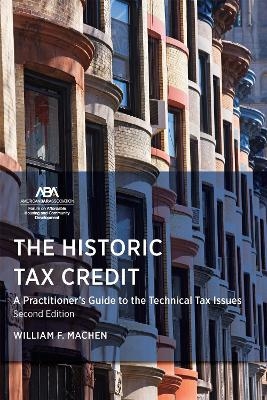
The Historic Tax Credit
A Practitioner's Guide to the Technical Tax Issues, 2nd Edition
Seiten
2024
American Bar Association (Verlag)
978-1-63905-392-6 (ISBN)
American Bar Association (Verlag)
978-1-63905-392-6 (ISBN)
Section 47 of the Internal Revenue Code of 1986, as amended (the "Code"), allows taxpayers to claim a credit (the "Rehabilitation Tax Credit") for certain expenses incurred in connection with the rehabilitation of older or historic buildings. The amount of the credit is 20 percent of the "qualified rehabilitation expenditures" incurred in connection with a "certified rehabilitation" of a "certified historic structure" or 10 percent of the qualified rehabilitation expenditures incurred with respect to a nonresidential building placed in service before 1936.
A certified historic structure is a building that either is listed as such in the National Register of Historic Places (the "National Register") or is located in a "registered historic district" and is certified by the Secretary of the Interior (the "Secretary"), acting through the National Park Service (the "NPS"), as being of historic significance to the district.
A registered historic district includes any district listed in the National Register, as well as a district statutorily designated by a state or local government, provided that the relevant statute has been certified by the Secretary as incorporating proper criteria for substantially achieving the purpose of preserving and rehabilitating historically significant buildings, and the district is certified by the Secretary as satisfying substantially all of the requirements for the listing of districts in the National Register.
A certified historic structure is a building that either is listed as such in the National Register of Historic Places (the "National Register") or is located in a "registered historic district" and is certified by the Secretary of the Interior (the "Secretary"), acting through the National Park Service (the "NPS"), as being of historic significance to the district.
A registered historic district includes any district listed in the National Register, as well as a district statutorily designated by a state or local government, provided that the relevant statute has been certified by the Secretary as incorporating proper criteria for substantially achieving the purpose of preserving and rehabilitating historically significant buildings, and the district is certified by the Secretary as satisfying substantially all of the requirements for the listing of districts in the National Register.
| Erscheinungsdatum | 04.06.2024 |
|---|---|
| Zusatzinfo | Illustrations |
| Verlagsort | Chicago, IL |
| Sprache | englisch |
| Maße | 228 x 152 mm |
| Themenwelt | Recht / Steuern ► EU / Internationales Recht |
| Recht / Steuern ► Privatrecht / Bürgerliches Recht ► Baurecht (privat) | |
| Recht / Steuern ► Privatrecht / Bürgerliches Recht ► Sachenrecht | |
| Recht / Steuern ► Steuern / Steuerrecht | |
| Recht / Steuern ► Strafrecht ► Besonderes Strafrecht | |
| ISBN-10 | 1-63905-392-1 / 1639053921 |
| ISBN-13 | 978-1-63905-392-6 / 9781639053926 |
| Zustand | Neuware |
| Haben Sie eine Frage zum Produkt? |
Mehr entdecken
aus dem Bereich
aus dem Bereich
Gesetz gegen Wettbewerbsbeschränkungen - GWB - 4. Teil, …
Buch | Softcover (2024)
dtv Verlagsgesellschaft
23,90 €
Kommentar unter besonderer Berücksichtigung des deutschen und …
Buch | Hardcover (2023)
Kohlhammer (Verlag)
149,00 €


